Adolf Hitler, the infamous dictator of Nazi Germany, is a figure whose image is heavily imprinted in the annals of history. Beyond his political ideologies and military strategies, the Adolf Hitler Uniform played a significant role in constructing his persona and projecting power. This article delves into the evolution of Adolf Hitler’s uniforms, from his humble beginnings as a soldier in World War I to his iconic attire as the Führer of the Third Reich.
World War I Uniform: Humble Beginnings in the Trenches
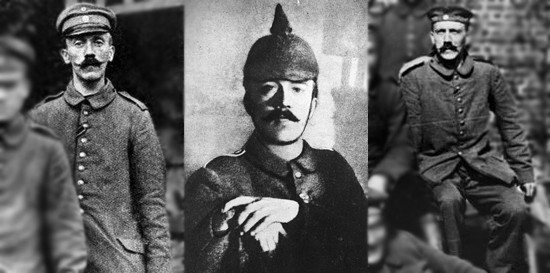
At the onset of World War I in August 1914, Adolf Hitler, then an Austrian national, volunteered for service in the Bavarian Army. He joined the Bavarian Reserve Infantry Regiment 16, specifically the 1st Company of the List Regiment, and served throughout the war on the Western Front in France and Belgium. During this period, Hitler’s adolf hitler uniform was that of a typical German soldier of the time. Initially a Schütze (Private), he was later promoted to Gefreiter (Lance Corporal) after the First Battle of Ypres in 1914 – the highest rank a soldier could achieve without becoming a non-commissioned officer. His role shifted to that of a regimental message-runner, a dangerous job that exposed him to the brutal realities of trench warfare.
The German Army uniform in 1914 still bore the hallmarks of 19th-century military fashion. While a modernization effort in 1910 had shifted the color from blue to field grey (Feldgrau), the basic design and officer/NCO rank insignia remained largely unchanged. However, the harsh realities of World War I quickly demonstrated the impracticality of pre-war uniform standards. In 1915, the German High Command initiated simplifications to field uniforms to address the demands of industrialized warfare, marking a shift from ceremonial appearances to functional battlefield attire. Hitler’s early military experience and the standard-issue adolf hitler uniform of World War I laid the foundation for his later fascination with military aesthetics and symbolism.
The NSDAP Uniform: From Party Leader to Political Icon
In the nascent stages of the Nazi Party (NSDAP), a standardized adolf hitler uniform was non-existent. Party members, often drawn from paramilitary groups, commonly wore a variety of uniforms, most notably the brown shirt of the Sturmabteilung (SA) during party rallies and public appearances. As the NSDAP grew in organization and influence, the need for official party uniforms became apparent. Around 1930, the first official NSDAP uniforms began to emerge, primarily consisting of a brown shirt or tunic paired with brown trousers and distinctive party insignia. These early adolf hitler uniforms for party members served to visually unify and distinguish the movement.
By 1932, further regulations formalized the NSDAP uniform system, introducing braided shoulder boards and collar rank insignia to denote hierarchy within the party structure. The Machtergreifung (Seizure of Power) in 1933 and the subsequent consolidation of Nazi power in 1934 led to a significant reorganization of the party and its uniform system. The NSDAP was structured into hierarchical levels: Ortsgruppen (local groups), Kreisleitung (district leadership), Gauleitung (regional leadership), and Reichsleitung (national leadership). Each level was further subdivided into ranks, each with its own specific shoulder board, collar insignia, and armband designs, creating a complex visual language of party affiliation and authority within the adolf hitler uniform framework.
Adolf Hitler himself, along with other top-ranking party officials like Joseph Goebbels, typically did not wear specific rank insignia within the NSDAP uniform system. Instead, Hitler’s adolf hitler uniform usually consisted of a standard brown jacket worn with black or brown trousers. Key identifiers were his party badge, often the prestigious Golden Party Badge, and the ubiquitous NSDAP armband. However, the specifics of Hitler’s adolf hitler uniform varied depending on the occasion:
-
Single-breasted brown jacket, brown trousers, belt: Often seen in more formal party settings.
-
Single-breasted brown jacket, brown trousers, no belt: A slightly less formal variation.
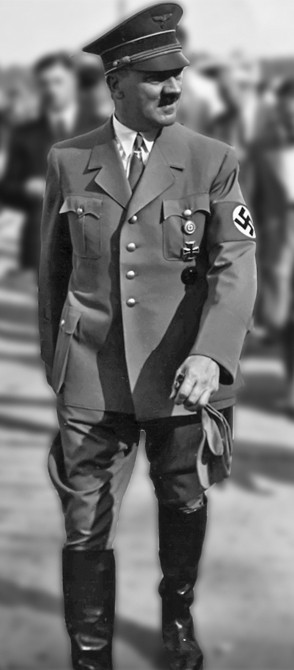 Alt text: Adolf Hitler in a single-breasted brown NSDAP jacket and brown trousers, without a belt, showcasing a less formal style of his party uniform.
Alt text: Adolf Hitler in a single-breasted brown NSDAP jacket and brown trousers, without a belt, showcasing a less formal style of his party uniform.
-
Single-breasted brown jacket, black trousers, no belt: Another common combination for Hitler’s adolf hitler uniform.
-
Double-breasted brown jacket, black trousers (starting 1938): This style became more prevalent later in the 1930s, adding a more formal and authoritative dimension to the adolf hitler uniform.
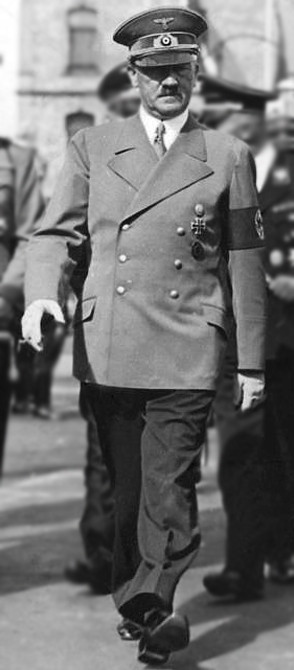 Alt text: A photo of Adolf Hitler wearing a double-breasted brown NSDAP jacket with black trousers, a later style of his party attire adopted around 1938, projecting a more commanding image.
Alt text: A photo of Adolf Hitler wearing a double-breasted brown NSDAP jacket with black trousers, a later style of his party attire adopted around 1938, projecting a more commanding image.
Beyond these standard combinations, the adolf hitler uniform repertoire also included variations for specific contexts:
-
White Uniform: Like the Wehrmacht and SS, the NSDAP had white summer uniforms, worn between April and October. Hitler possessed both single and double-breasted white jackets, which could be paired with matching white or black trousers. He sometimes added a brocade belt for added formality. While he typically wore his standard brown visor cap with the white uniform, he occasionally opted for a matching white visor cap.
-
Brown Shirt/SA Shirt: Before 1933 and his ascent to Chancellor, Hitler frequently wore the iconic brown shirt, the uniform of the SA, at party rallies and events. After seizing power, he reserved the brown shirt for only two annual events: the Putsch Commemoration on November 9th and the SA and SS day and Blutfahne Consecration during the annual Reichsparteitag (Nuremberg Rally). Although rarely seen wearing the SA kepi (peaked cap), reportedly disliking photographs of himself in it after an early photoshoot by Heinrich Hoffmann, he often carried it in hand during the NSDAP’s early years. Up until around 1927/28, Hitler was also occasionally seen wearing the brown shirt with Lederhosen, traditional Bavarian leather breeches, reflecting the regional origins of the Nazi movement.
-
Visor Cap: Headgear within the early NSDAP was not standardized, with many leaders favoring SA kepis. Visor caps were officially introduced in 1933. Hitler’s adolf hitler uniform visor cap was distinctive; he requested a longer visor to shield his eyes due to photosensitivity stemming from a World War I mustard gas attack that had temporarily blinded him. His cap was initially plain, lacking a cockade, until early 1938. Subsequently, he adopted a supreme commander visor cap adorned with an embroidered golden wreath and bullion, signifying his supreme authority.
-
Belts and Belt Buckles: Belts were a standard component of the NSDAP uniform. Photographs reveal Hitler wearing three distinct belt buckles throughout his time as party leader and Führer. The first buckle was rounded and used until August 1934. A third design appeared from October 1937 onwards. Interestingly, Hitler was sometimes seen wearing the full adolf hitler uniform without a belt, suggesting a degree of informality depending on the event. Official events typically saw him wearing a belt, while more casual settings might not. The belt color itself also evolved, transitioning from a chocolate brown to a darker shade.
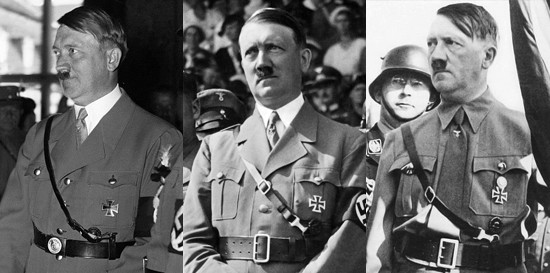 Alt text: A close-up image showcasing the belt buckle detail of Adolf Hitler’s NSDAP uniform, highlighting an important accessory in his party attire.
Alt text: A close-up image showcasing the belt buckle detail of Adolf Hitler’s NSDAP uniform, highlighting an important accessory in his party attire.
Field Grey Wartime Uniform: Embracing the Image of the ‘First Soldier’
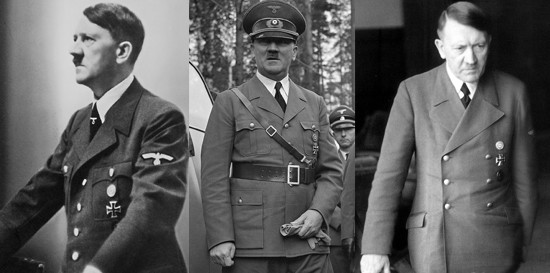
From the invasion of Poland on September 1, 1939, marking the start of World War II, until his death in 1945, Adolf Hitler made a deliberate and symbolic shift in his attire. He chose to exclusively wear the field grey uniform of the German Army. This decision was rooted in his self-proclaimed role as the “first soldier” of the Reich, aligning himself with the Wehrmacht and projecting an image of military leadership during wartime. Remarkably, Hitler adhered to this choice even in his private life during World War II; photographic evidence shows no instances of him in civilian clothing or even his NSDAP uniform during this period. The adolf hitler uniform became synonymous with the field grey of the Wehrmacht.
This wartime adolf hitler uniform could take several forms. It included a standard field grey tunic, sometimes worn with a belt and sometimes without, mirroring his NSDAP uniform variations. He also favored a double-breasted field grey jacket, often paired with black trousers and worn without a belt.
Traudl Junge, one of Hitler’s secretaries from 1942 until the end of the war, provided a vivid description of his consistent wartime attire in her memoirs, “Hitler’s Last Secretary”: “He was wearing his usual black trousers, double-breasted field-grey coat, white shirt and black tie. I never saw him in anything else. His jacket was always perfectly plain, with silver buttons, but no braid or decorations. He just wore the golden Party badge on the left side of his chest, the Iron Cross and the black decoration for the wounded.” This account underscores the stark simplicity and deliberate military focus of Hitler’s adolf hitler uniform during the war’s tumultuous years.
Conclusion
The adolf hitler uniform was not a static entity but rather a reflection of his evolving roles and ambitions. From the functional field grey of a World War I soldier to the symbolic brown and white uniforms of the NSDAP leader and finally the wartime adoption of the Wehrmacht field grey, Hitler’s clothing choices were carefully constructed and laden with meaning. These uniforms served to project power, solidify his image, and communicate his shifting political and military identities to both his followers and the world. The study of the adolf hitler uniform provides a fascinating insight into the persona of a dictator and the calculated use of visual symbolism in shaping historical narratives.
